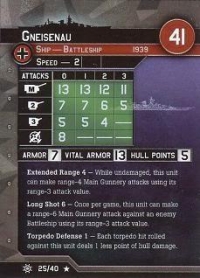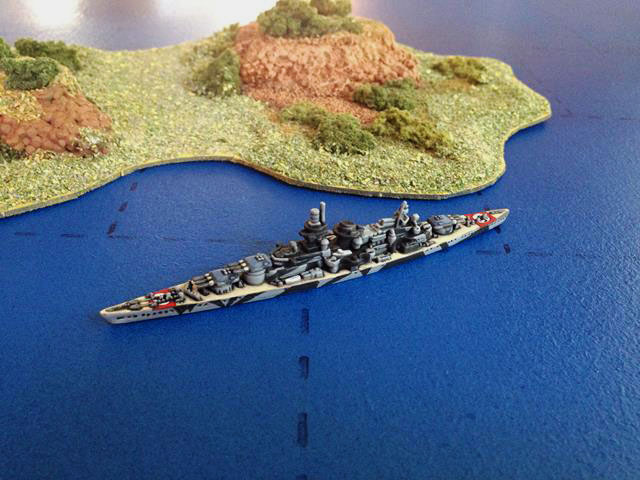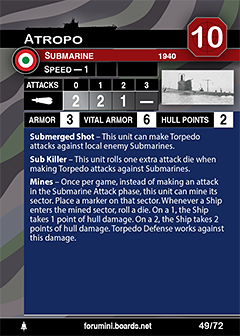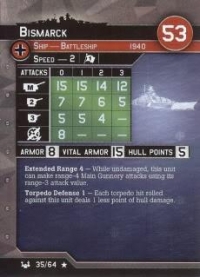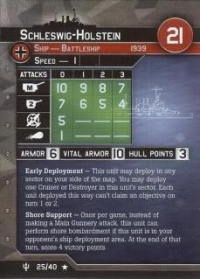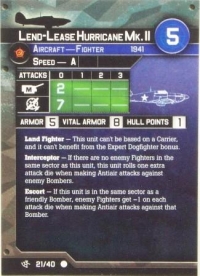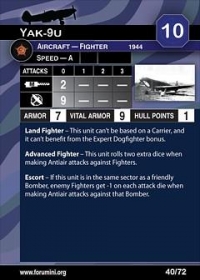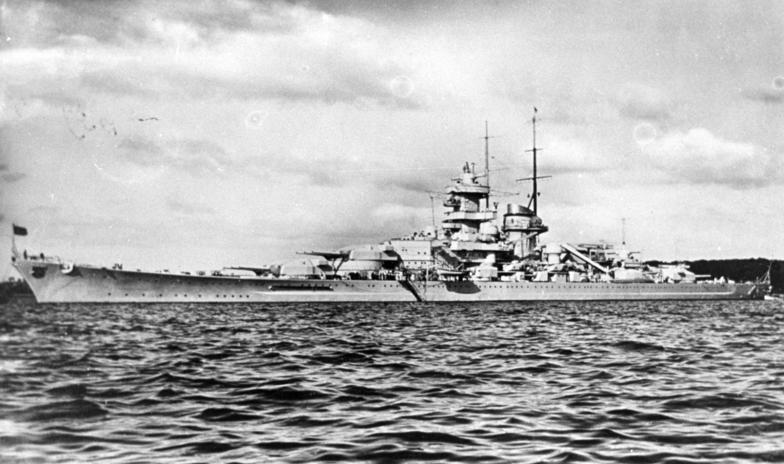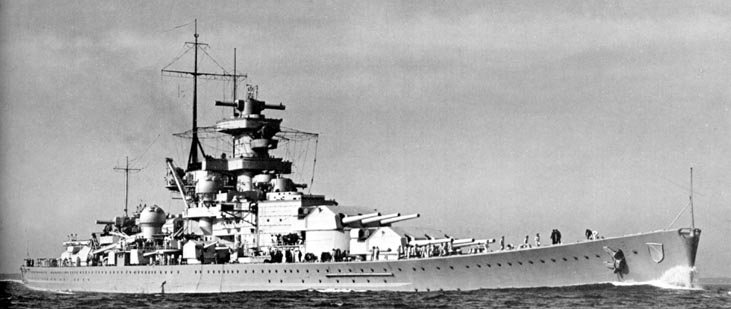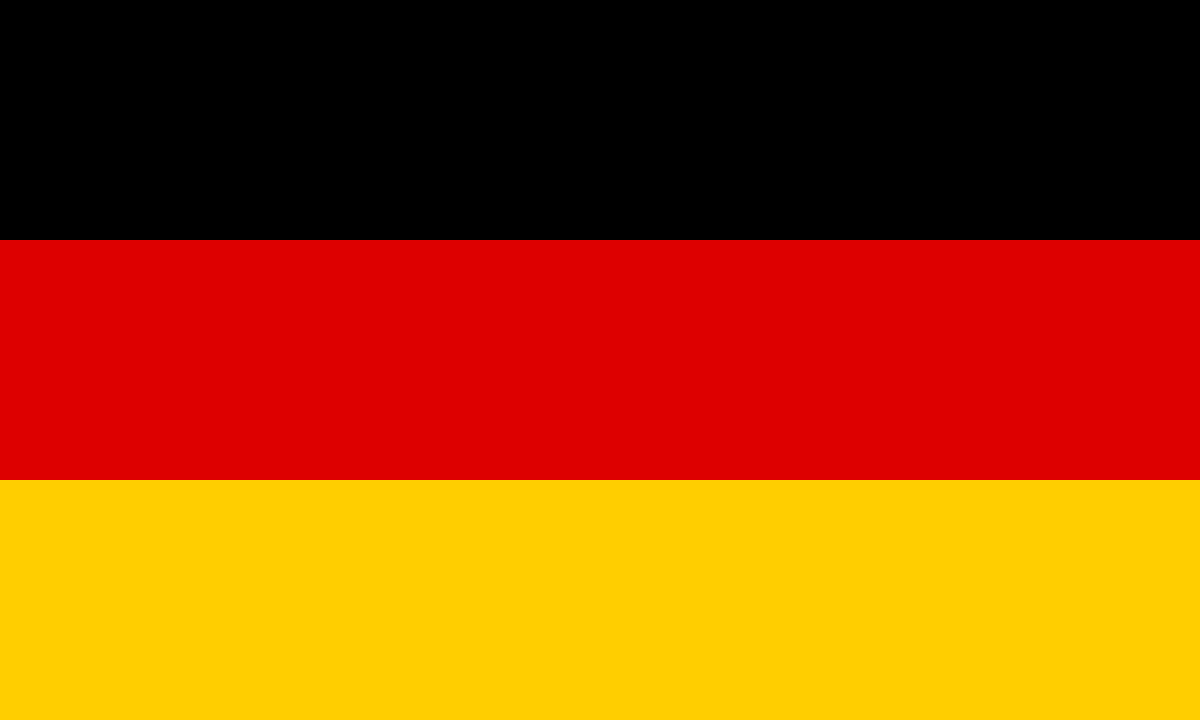Gneisenau
| General Type | Ship |
| Unit Type | Battleship |
| Cost | 41 |
| Set | Condition Zebra |
| Manufacturer | Hasbro |
| Available | 1939 |
| Set ID | 25 |
| Game Class Limits | Scharnhorst |
| Country | Germany (Details) |
| Prototype | Gneisenau (Details) |
| Class | Scharnhorst (Details) |
| Armor | 7 |
| Vital | 13 |
| Hull Points | 5 |
| Speed | 139 |
| Primary | 13/13/12/11 |
| Secondary | 7/7/6/5 |
| Tertiary | 5/5/4/- |
| AA | 8/0/-/- |
| Special Ability | Long Shot 6 |
| Special Ability | Extended Range 4 |
| Special Ability | Torpedo Defense 1 |
| Game Rarity | R |
Click to see the details
market
Click to see the details
history
Click to see the details
collector
Prototype:
Gneisenau was a German capital ship, alternatively described as a battleship and battlecruiser, of Nazi Germany's Kriegsmarine. She was the second vessel of her class, which included one other ship, Scharnhorst. The ship was built at the Deutsche Werke dockyard in Kiel; she was laid down on 6 May 1935 and launched on 8 December 1936. Completed in May 1938, the ship was armed with a main battery of nine 28 cm (11 in) C/34 guns in three triple turrets, though there were plans to replace these weapons with six 38 cm (15 in) SK C/34 guns in twin turrets.
Gneisenau and Scharnhorst operated together for much of the early portion of World War II, including sorties into the Atlantic to raid British merchant shipping. During their first operation, the two ships sank the British auxiliary cruiser HMS Rawalpindi in a short battle. Gneisenau and Scharnhorst participated in Operation Weserübung, the German invasion of Norway. During operations off Norway, the two ships engaged the battlecruiser HMS Renown and sank the aircraft carrier HMS Glorious. Gneisenau was damaged in the action with Renown and later torpedoed by a British submarine, HMS Clyde, off Norway. After a successful raid in the Atlantic in 1941, Gneisenau and her sister put in at Brest, France. The two battleships were the subject of repeated bombing raids by the RAF; Gneisenau was hit several times during the raids, though she was ultimately repaired.
In early 1942, the two ships made a daylight dash up the English Channel from occupied France to Germany. After reaching Kiel in early February, the ship went into drydock. On the night of 26 February, the British launched an air attack on the ship; one bomb penetrated her armored deck and exploded in the forward ammunition magazine, causing serious damage and a large number of casualties. The repairs necessitated by the damage were so time-consuming that it was determined to rebuild the ship to accommodate the 38 cm guns as originally intended. The 28 cm guns were removed and used as shore batteries. In 1943, Hitler ordered the cessation of conversion work, and on 27 March 1945, she was sunk as a blockship in Gotenhafen (Gdynia) in German-occupied Poland. She was eventually broken up for scrap in 1951.
Gneisenau and Scharnhorst operated together for much of the early portion of World War II, including sorties into the Atlantic to raid British merchant shipping. During their first operation, the two ships sank the British auxiliary cruiser HMS Rawalpindi in a short battle. Gneisenau and Scharnhorst participated in Operation Weserübung, the German invasion of Norway. During operations off Norway, the two ships engaged the battlecruiser HMS Renown and sank the aircraft carrier HMS Glorious. Gneisenau was damaged in the action with Renown and later torpedoed by a British submarine, HMS Clyde, off Norway. After a successful raid in the Atlantic in 1941, Gneisenau and her sister put in at Brest, France. The two battleships were the subject of repeated bombing raids by the RAF; Gneisenau was hit several times during the raids, though she was ultimately repaired.
In early 1942, the two ships made a daylight dash up the English Channel from occupied France to Germany. After reaching Kiel in early February, the ship went into drydock. On the night of 26 February, the British launched an air attack on the ship; one bomb penetrated her armored deck and exploded in the forward ammunition magazine, causing serious damage and a large number of casualties. The repairs necessitated by the damage were so time-consuming that it was determined to rebuild the ship to accommodate the 38 cm guns as originally intended. The 28 cm guns were removed and used as shore batteries. In 1943, Hitler ordered the cessation of conversion work, and on 27 March 1945, she was sunk as a blockship in Gotenhafen (Gdynia) in German-occupied Poland. She was eventually broken up for scrap in 1951.
Class History:
The Scharnhorst class were the first capital ships, alternatively referred to as battlecruisers or battleships, built for Nazi Germany's Kriegsmarine after World War I. The class comprised two vessels: the lead ship Scharnhorst and Gneisenau. Scharnhorst was launched first and so she is considered to be the lead ship by some sources; however, they are also referred to as the Gneisenau class in some other sources as Gneisenau was the first to be laid down and commissioned They marked the beginning of German naval rearmament after the Treaty of Versailles. The ships were armed with nine 28 cm (11 in) SK C/34 guns in three triple turrets, though there were plans to replace these weapons with six 38 cm (15 in) SK C/34 guns in twin turrets.
The two ships were laid down in 1935, launched in late 1936, and commissioned into the German fleet by early 1939. Scharnhorst and Gneisenau operated together for much of the early portion of World War II, including sorties into the Atlantic to raid British merchant shipping. The two ships participated in Operation Weserübung, the German invasion of Norway. During operations off Norway, the two ships engaged the battlecruiser HMS Renown and sank the aircraft carrier HMS Glorious on 8 June 1940. In the engagement with Glorious, Scharnhorst achieved one of the longest-range naval gunfire hits in history. In early 1942, the two ships made a daylight dash up the English Channel from occupied France to Germany.
In late 1942, Gneisenau was heavily damaged in an Allied air raid against Kiel. In early 1943, Scharnhorst joined the Bismarck-class Tirpitz in Norway to interdict Allied convoys to the Soviet Union. Scharnhorst and several destroyers sortied from Norway to attack a convoy; the Germans were instead intercepted by British naval patrols. During the battle of North Cape, the Royal Navy battleship HMS Duke of York sank Scharnhorst. In the meantime, repair work on Gneisenau had begun, and the ship was in the process of being rearmed. However, when Scharnhorst was sunk, work on her sister was abandoned. Instead, she was sunk as a blockship in Gotenhafen in 1945; the wreck was broken up for scrap in the 1950s.
The two ships were laid down in 1935, launched in late 1936, and commissioned into the German fleet by early 1939. Scharnhorst and Gneisenau operated together for much of the early portion of World War II, including sorties into the Atlantic to raid British merchant shipping. The two ships participated in Operation Weserübung, the German invasion of Norway. During operations off Norway, the two ships engaged the battlecruiser HMS Renown and sank the aircraft carrier HMS Glorious on 8 June 1940. In the engagement with Glorious, Scharnhorst achieved one of the longest-range naval gunfire hits in history. In early 1942, the two ships made a daylight dash up the English Channel from occupied France to Germany.
In late 1942, Gneisenau was heavily damaged in an Allied air raid against Kiel. In early 1943, Scharnhorst joined the Bismarck-class Tirpitz in Norway to interdict Allied convoys to the Soviet Union. Scharnhorst and several destroyers sortied from Norway to attack a convoy; the Germans were instead intercepted by British naval patrols. During the battle of North Cape, the Royal Navy battleship HMS Duke of York sank Scharnhorst. In the meantime, repair work on Gneisenau had begun, and the ship was in the process of being rearmed. However, when Scharnhorst was sunk, work on her sister was abandoned. Instead, she was sunk as a blockship in Gotenhafen in 1945; the wreck was broken up for scrap in the 1950s.
Country:
Germany is a Western European country with a landscape of forests, rivers, mountain ranges and North Sea beaches. It has over 2 millennia of history. Berlin, its capital, is home to art and nightlife scenes, the Brandenburg Gate and many sites relating to WWII. Munich is known for its Oktoberfest and beer halls, including the 16th-century Hofbräuhaus. Frankfurt, with its skyscrapers, houses the European Central Bank.
Item created by: Lethe
on 2015-05-31 17:46:30
Last edited by: gdm on 2019-07-16 11:40:18
If you see errors or missing data in this entry, please feel free to log in and edit it. Anyone with a Gmail account can log in instantly.
Last edited by: gdm on 2019-07-16 11:40:18
If you see errors or missing data in this entry, please feel free to log in and edit it. Anyone with a Gmail account can log in instantly.


